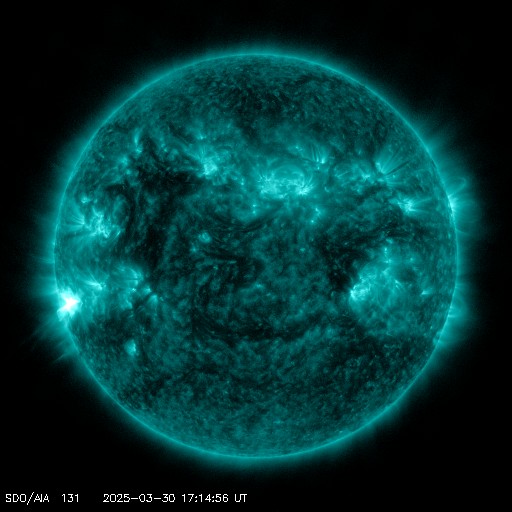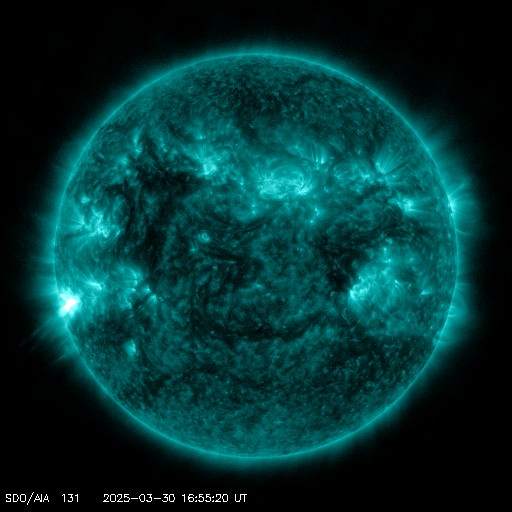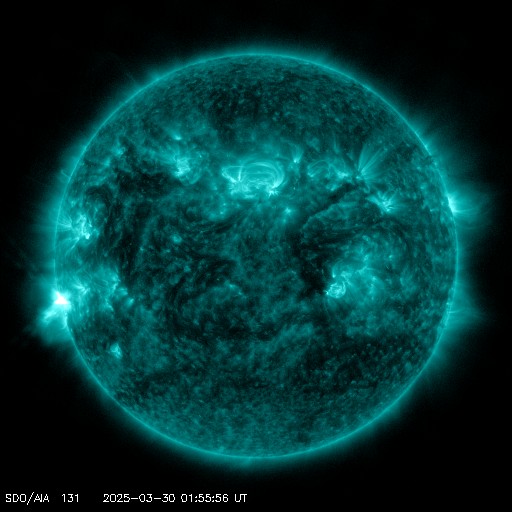Viewing archive of Friday, 25 April 2003
Solar activity report
Any mentioned solar flare in this report has a scaling factor applied by the Space Weather Prediction Center (SWPC). Because of the SWPC scaling factor, solar flares are reported as 42% smaller than for the science quality data. The scaling factor has been removed from our archived solar flare data to reflect the true physical units.
Report of Solar-Geophysical Activity 2003 Apr 25 2200 UTCPrepared by the NOAA © SWPC and processed by SpaceWeatherLive.com
Joint USAF/NOAA Report of Solar and Geophysical Activity
SDF Number 115 Issued at 2200Z on 25 Apr 2003IA. Analysis of Solar Active Regions and Activity from 24-2100Z to 25-2100Z
Solar activity remained at moderate levels today. The
largest flare of the period was an M1/Sf which occurred at 25/0540Z
from Region 346 (N16E61) and had an associated Type II radio sweep
with an estimated shock velocity of 814 km/s. There seems to be
little magnetic complexity to this region based on a single Hsx spot
seen in white-light. Region 337 (S14W13) appears to have changed
little since yesterday and remains a beta-gamma magnetic complex.
Region 338 (N18W58) produced the majority of the flare activity
throughout the interval which was limited to C-class events.
Magnetically, this region appears to be in a decay phase as a
single delta complex remains apparent verses the several complexes
analyzed earlier in the period. No new regions were numbered today.
IB. Solar Activity Forecast
Solar activity is expected to be at
low to moderate levels. Region 338 remains capable of producing
M-class events.
IIA. Geophysical Activity Summary 24-2100Z to 25-2100Z
The geomagnetic field was at predominantly active to minor storm
levels. High speed solar wind speeds along with embedded transient
activity are believed to be responsible for the elevated conditions.
The greater than 2 MeV electron fluxes at geosynchronous orbit
reached high levels again today.
IIB. Geophysical Activity Forecast
The geomagnetic field is
expected to be at active to minor storm levels with isolated major
storm conditions possible throughout the period. High speed coronal
hole flow may continue to be enhanced by transient activity for the
entire interval. A weak CME impact from the M5 flare on April 23 is
possible on day one. Further CME effects are possible on day two
resulting from the M3 flare that occurred on 24 April. The M1 that
occurred today may have a very weak impact late on day two into day
three.
III. Event Probabilities 26 Apr to 28 Apr
| Class M | 50% | 50% | 50% |
| Class X | 05% | 05% | 05% |
| Proton | 05% | 05% | 05% |
| PCAF | green | ||
IV. Penticton 10.7 cm Flux
Observed 25 Apr 144 Predicted 26 Apr-28 Apr 145/150/145 90 Day Mean 25 Apr 126
V. Geomagnetic A Indices
Observed Afr/Ap 24 Apr 024/024 Estimated Afr/Ap 25 Apr 020/025 Predicted Afr/Ap 26 Apr-28 Apr 020/025-020/025-015/020
VI. Geomagnetic Activity Probabilities 26 Apr to 28 Apr
| A. Middle Latitudes | |||
|---|---|---|---|
| Active | 45% | 45% | 30% |
| Minor storm | 25% | 25% | 20% |
| Major-severe storm | 15% | 15% | 10% |
| B. High Latitudes | |||
|---|---|---|---|
| Active | 40% | 40% | 45% |
| Minor storm | 30% | 30% | 25% |
| Major-severe storm | 20% | 20% | 15% |
All times in UTC
Current data suggests there is a slight possibility for aurora to appear at the following high latitude regions in the near future
Norilsk, VorkutaLatest news
Latest forum messages
More topicsSupport SpaceWeatherLive.com!
A lot of people come to SpaceWeatherLive to follow the Sun's activity or if there is aurora to be seen, but with more traffic comes higher server costs. Consider a donation if you enjoy SpaceWeatherLive so we can keep the website online!

Latest alerts
17:27 UTC - Solar flare
Moderate M1.5 flare
17:03 UTC - Solar flare
Moderate M1.61 flare
16:45 UTC - Radio Blackout
Minor R1 radio blackout in progress (≥M1 - current: M1.61)
02:09 UTC - Solar flare
Moderate M1.54 flare from sunspot region 4048
01:42 UTC - Radio Blackout
Minor R1 radio blackout in progress (≥M1 - current: M1.24)
Space weather facts
| Last X-flare | 2025/03/28 | X1.1 |
| Last M-flare | 2025/03/30 | M1.4 |
| Last geomagnetic storm | 2025/03/27 | Kp5 (G1) |
| Spotless days | |
|---|---|
| Last spotless day | 2022/06/08 |
| Monthly mean Sunspot Number | |
|---|---|
| February 2025 | 154.6 +17.6 |
| March 2025 | 127.5 -27.1 |
| Last 30 days | 127.5 -24.7 |





